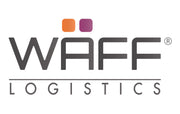In the fast-paced world of logistics and warehousing, safety isn't just a policy-it's the bedrock of operational excellence. A single oversight can cascade into significant downtime, costly damages, and, most importantly, serious injuries. Moving beyond a simple tick-box exercise, a truly effective warehouse safety checklist is a dynamic, living document that transforms your facility from a place of potential hazards into a fortress of productivity and well-being. This guide breaks down the eight critical pillars that form an unbreakable safety culture.
From the personal gear your team wears to the structural integrity of your storage systems, each element is a vital component in a comprehensive safety strategy. We will provide actionable insights and real-world examples to help you not just meet compliance standards but exceed them, creating a safer, more efficient environment for everyone. You will learn to implement robust protocols covering everything from Personal Protective Equipment (PPE) and forklift operations to fire preparedness and chemical handling.
For businesses in Canada and the USA, particularly those in manufacturing, e-commerce, and distribution, embedding these protocols is fundamental. Whether you manage your own space or partner with a 3PL provider, a proactive approach to safety protects your most valuable assets: your people and your products. This checklist is your blueprint for building a resilient, compliant, and highly productive operation.
1. Personal Protective Equipment (PPE) Compliance
Your team's first line of defence against preventable injury isn't a policy document; it's the gear they wear every single day. Integrating a stringent Personal Protective Equipment (PPE) compliance check into your daily workflow is a non-negotiable part of a comprehensive warehouse safety checklist. This isn't just about having equipment available; it's a systematic verification process ensuring every team member is properly outfitted and protected from specific, identified hazards.
A robust PPE program moves beyond simple provision. It involves daily inspections of equipment condition, verification of proper fit, and unwavering adherence to Canadian safety standards like those set by the Canadian Centre for Occupational Health and Safety (CCOHS). This protocol is crucial for preventing injuries from falling objects, hazardous material exposure, and accidents involving heavy machinery.
Real-World Application and Best Practices
Leading companies demonstrate the power of a well-enforced PPE strategy. Amazon's Canadian fulfillment centres, for instance, mandate certified steel-toed boots and high-visibility safety vests for all personnel on the warehouse floor. Similarly, UPS facilities require reflective clothing and protective bump caps in high-traffic loading dock areas to mitigate collision risks.
To elevate your own compliance, consider these actionable strategies:
- Implement a "Buddy System": Task team members with quick, mutual PPE checks at the start of each shift. This fosters a culture of shared responsibility.
- Provide Variety: Stock multiple sizes and styles of gloves, safety glasses, and other gear. A proper fit is essential for both comfort and effectiveness; ill-fitting PPE is often discarded or worn improperly.
- Schedule Regular Refreshers: Conduct mandatory training updates every six months to reinforce proper use, care, and the importance of each piece of equipment.
Key Insight: Effective PPE compliance isn't a one-time setup. It's an ongoing, active process of verification, training, and cultural reinforcement that turns safety from a rule into a reflex.
This infographic outlines a simple yet effective daily workflow to ensure consistent PPE compliance.
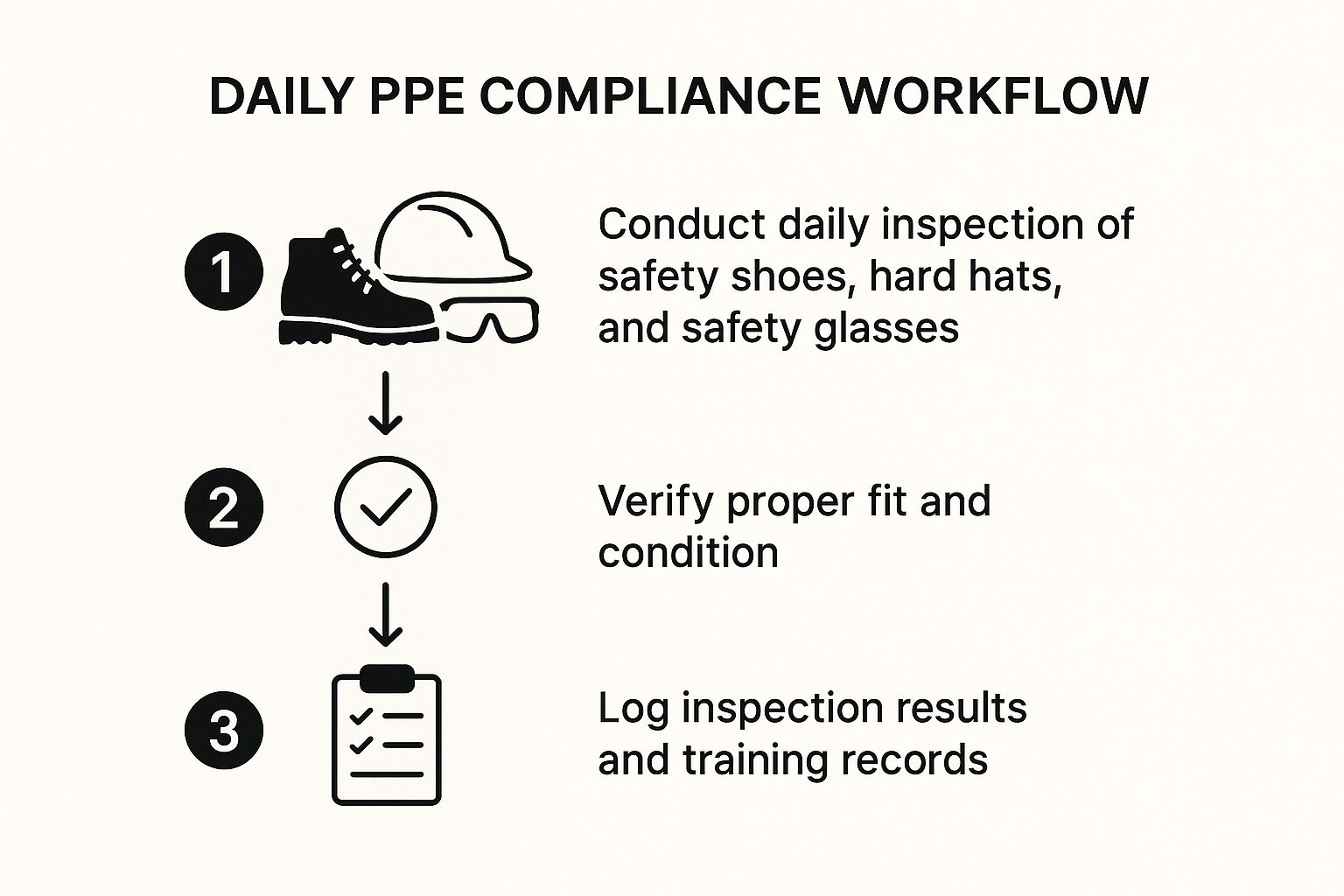
Following this clear, sequential process ensures that no step is missed and that compliance is documented, creating a verifiable safety record.
2. Forklift and Material Handling Equipment Safety
The movement of powered industrial trucks and materials represents the highest-risk activity within most warehouse environments. A systematic protocol for forklift and material handling equipment is therefore a cornerstone of any effective warehouse safety checklist. This goes far beyond basic operator training; it involves a comprehensive system of daily inspections, traffic management, and stringent maintenance schedules to prevent incidents that often lead to the most severe injuries and fatalities.
Establishing a culture of equipment safety means treating every piece of machinery, from forklifts to conveyor systems, with a rigorous, documented process. This protocol, championed by organizations like the Industrial Truck Association (ITA) and the National Institute for Occupational Safety and Health (NIOSH), is essential for mitigating risks associated with equipment failure, operator error, and pedestrian collisions.
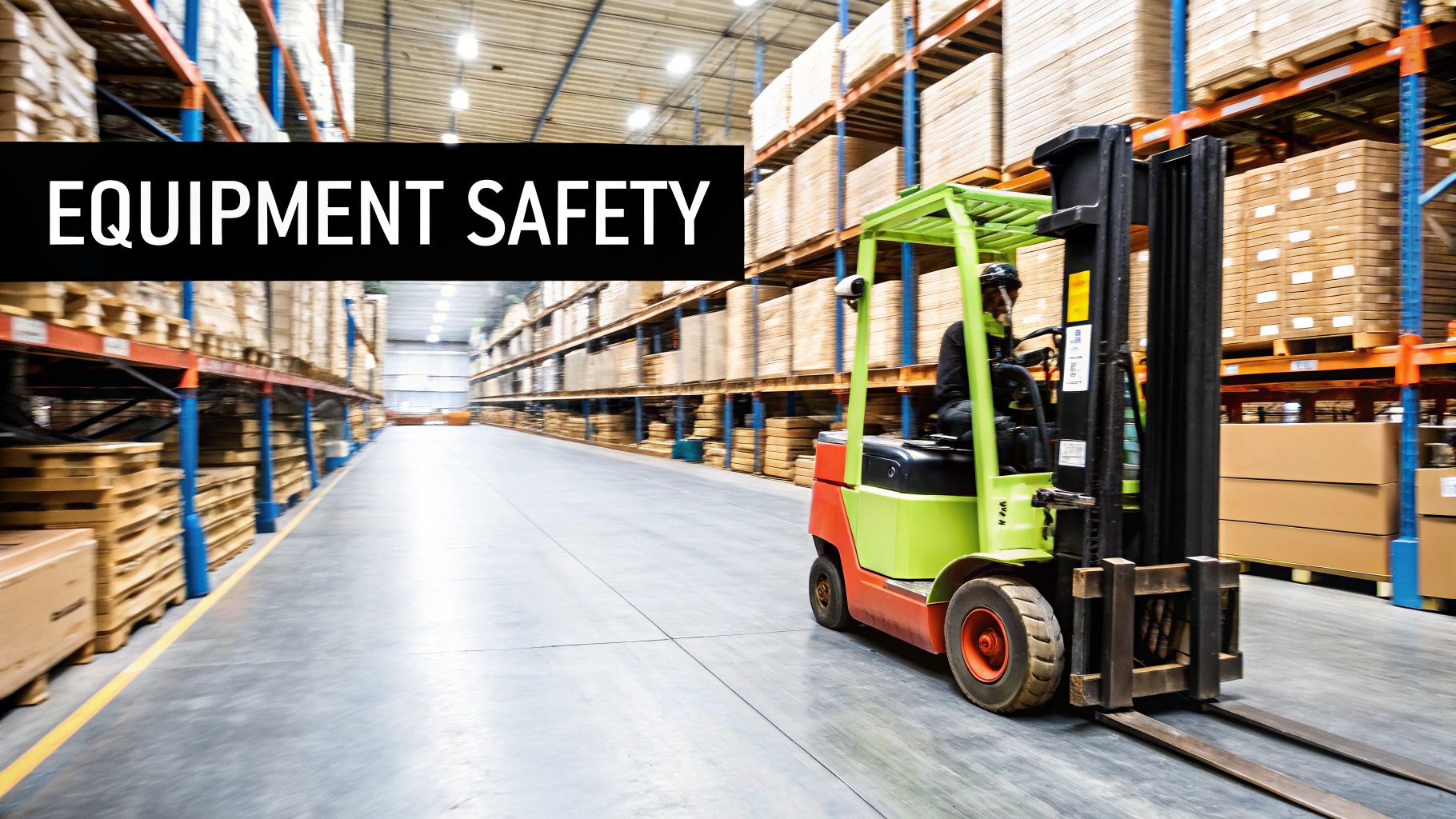
Real-World Application and Best Practices
Industry leaders provide a clear blueprint for excellence in material handling safety. Walmart's Canadian distribution centres, for example, utilize RFID-enabled forklifts that automatically log pre-shift inspection data, ensuring full compliance. FedEx facilities often implement segregated pedestrian walkways with physical barriers and advanced warning systems, while many Costco warehouses equip their forklifts with proximity sensors that audibly alert operators to nearby pedestrians. These practices demonstrate a commitment to proactively engineering a safer environment.
To enhance your own equipment safety protocols, consider these actionable strategies:
- Use Digital Inspection Apps: Transition from paper checklists to digital apps for real-time documentation and tracking of pre-operational checks. This creates an instant, auditable record of equipment status.
- Improve Visibility: Install large, convex mirrors at blind corners and intersections to give forklift operators and pedestrians a clear view of approaching traffic.
- Implement Lockout/Tagout (LOTO): Enforce a strict LOTO system for any equipment that is out of service or undergoing maintenance, preventing accidental startup and ensuring technician safety.
- Establish Designated Zones: Create clearly marked and protected areas for equipment charging and fuelling, keeping these activities away from high-traffic work zones.
Key Insight: Proactive equipment safety is not just about operator training; it's about creating an engineered system of checks, physical barriers, and technological aids that makes safe operation the default standard.
This video from Toyota Material Handling provides a visual guide to essential pre-operational forklift checks.
Integrating these meticulous checks and advanced strategies is crucial for achieving mastery in your facility. For a deeper look into this topic, you can learn more about warehousing and distribution best practices on wafflogistics.com.
3. Fire Safety and Emergency Preparedness
A warehouse fire can escalate with terrifying speed, threatening lives and bringing operations to a catastrophic halt. An itemized approach to fire safety and emergency preparedness is a fundamental pillar of any credible warehouse safety checklist. This involves more than just having fire extinguishers; it requires a multi-layered system of prevention, detection, suppression, and evacuation protocols that account for the unique risks posed by large inventories of combustible materials and complex layouts.
A truly effective strategy is proactive, not reactive. It integrates regular equipment inspections, clear and unobstructed egress routes, and comprehensive staff training into daily operations. By adhering to rigorous standards set by organizations like the National Fire Protection Association (NFPA), you transform a passive safety plan into an active defence mechanism, ensuring your team is prepared to respond decisively in an emergency.
Real-World Application and Best Practices
Industry leaders provide excellent models for robust fire safety systems. IKEA distribution centres, for example, employ advanced sprinkler systems integrated with early smoke detection technology to respond to fires before they can spread. Target warehouses often use compartmentalized fire suppression zones to contain incidents, while Procter & Gamble facilities utilize specialized foam systems to manage the risks associated with chemical storage areas.
To significantly upgrade your facility's fire readiness, implement these practical measures:
- Designate and Train Fire Wardens: Appoint and thoroughly train specific fire wardens for every shift and department. These individuals are responsible for guiding colleagues, ensuring areas are clear, and liaising with emergency services.
- Maintain Clear Egress: All emergency exits, pathways, and assembly points must be kept completely clear of obstruction, well-lit, and conspicuously marked at all times. This includes regular checks to prevent pallet or inventory creep into designated routes.
- Conduct Monthly Equipment Checks: Systematically inspect all fire extinguishers, sprinkler heads, and alarm systems every month. Document these checks in a dedicated log to maintain a verifiable record of compliance and readiness.
Key Insight: Comprehensive fire safety is not a single action but a continuous cycle of inspection, training, and environmental management. It ensures that when seconds count, your equipment works and your people know exactly what to do.
4. Slip, Trip, and Fall Prevention
The most frequent cause of workplace injuries isn't a complex machinery malfunction; it's the seemingly simple slip, trip, or fall. Implementing a vigilant housekeeping and hazard identification program is a foundational element of any effective warehouse safety checklist. This proactive approach focuses on maintaining clear, safe walking and working surfaces to mitigate risks that can lead to significant downtime, workers' compensation claims, and serious injuries.
This isn't just about mopping up the occasional spill. A truly comprehensive program involves systematic daily inspections of floor conditions, immediate and standardized spill response protocols, ensuring adequate lighting in all areas, and diligently removing any obstructions from pathways. It’s about creating an environment where these common hazards are systematically identified and eliminated before they can cause harm.
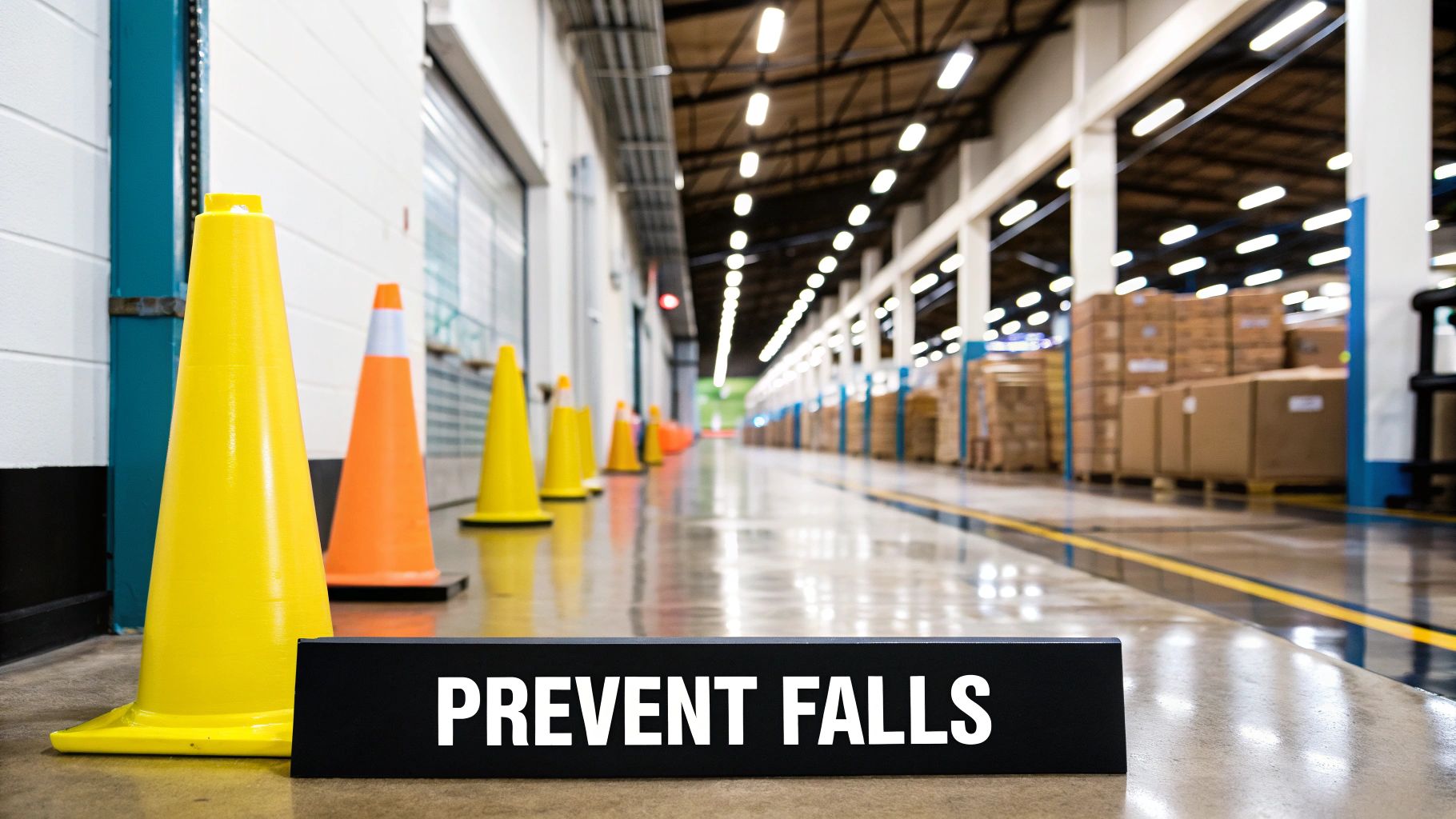
Real-World Application and Best Practices
Industry leaders provide excellent models for slip, trip, and fall prevention. Many Coca-Cola distribution centres, for example, apply specialized anti-slip coatings to high-traffic walking surfaces to enhance grip. Similarly, Best Buy warehouses have implemented immediate spill response protocols, with clearly marked and fully stocked cleanup stations strategically placed throughout the facility. Sysco's food distribution facilities often go a step further, utilizing flooring specifically engineered for performance in consistently wet conditions.
To drastically reduce these risks in your own operation, consider these actionable strategies:
- Establish a 'Clean As You Go' Policy: Empower and train every employee to take immediate ownership of cleaning up small spills, debris, or clutter in their work area. This prevents small issues from becoming major hazards.
- Improve Visibility and Marking: Use high-visibility, industrial-grade tape or paint to clearly mark pedestrian walkways, work cell boundaries, and any changes in floor elevation. Ensure lighting levels are at least 50 foot-candles in all walkways and storage areas.
- Utilize Strategic Matting: Install high-quality, non-slip mats in entranceways, transition areas between different flooring types (e.g., from the warehouse floor to an office), and any areas prone to moisture.
Key Insight: Proactive prevention is far more effective than reactive cleanup. A culture of constant vigilance and good housekeeping, where every team member is responsible for hazard identification, is the ultimate defence against slips, trips, and falls.
5. Chemical and Hazardous Material Storage
Improper handling of chemicals and hazardous materials presents one of the most severe risks within a warehouse setting, with potential consequences ranging from toxic exposure to fires and explosions. A dedicated protocol for their storage and management is a critical pillar of any effective warehouse safety checklist. This involves much more than just tucking containers away on a shelf; it's a systematic approach to identifying, segregating, and controlling every hazardous substance, from industrial cleaning supplies to lithium-ion batteries.
Managing these materials correctly is mandated by organizations like the Environmental Protection Agency (EPA) and enforced through standards set by bodies such as the National Institute for Occupational Safety and Health (NIOSH). A robust program ensures readily accessible Safety Data Sheets (SDS), clear labelling, secure containment, and established procedures for spill response, fundamentally protecting both your team and the environment.
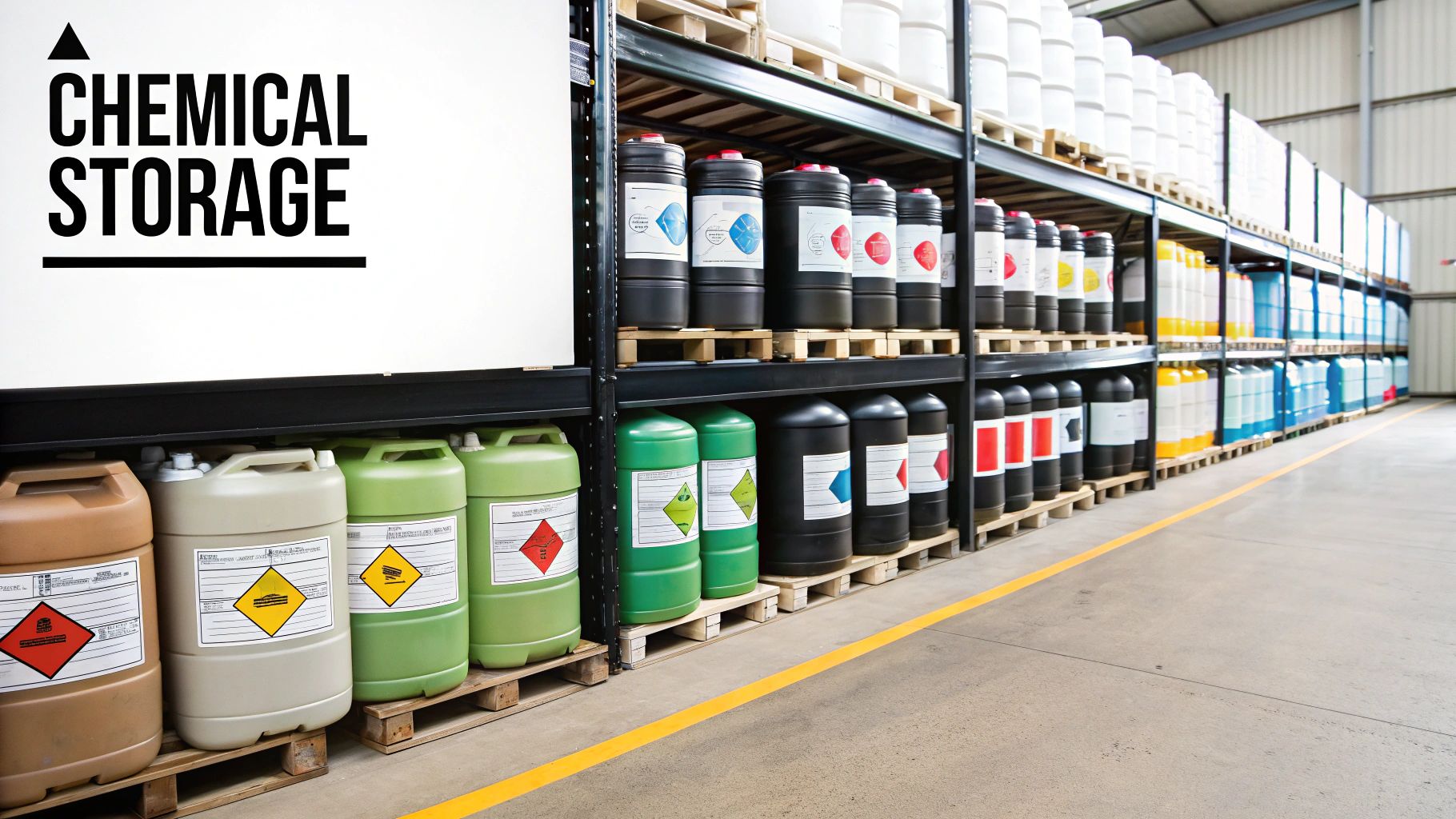
Real-World Application and Best Practices
Industry leaders provide clear blueprints for managing hazardous materials. Sherwin-Williams' distribution centres, for instance, utilize specialized, temperature-controlled storage areas for flammable paints and solvents. Likewise, Batteries Plus facilities implement strictly segregated storage zones with dedicated ventilation systems to prevent incidents involving battery acids or fumes, showcasing the importance of tailored safety measures.
To enhance your own hazardous material protocols, integrate these actionable strategies:
- Implement Colour-Coded Systems: Assign specific colours to different chemical classes (e.g., yellow for flammables, blue for health hazards). This visual cue system simplifies identification and helps prevent accidental mixing of incompatible substances.
- Install Accessible Emergency Equipment: Position eyewash stations and safety showers within a 10-second travel distance from any area where corrosive materials are handled, as recommended by OSHA and CCOHS guidelines.
- Establish a First-In, First-Out (FIFO) System: Use a strict inventory rotation for chemicals with an expiry date. This prevents the degradation of substances, which can lead to ineffective performance or increased hazard levels.
- Conduct Regular Container Integrity Checks: Schedule weekly inspections to check for leaks, corrosion, or damage to storage containers and ensure all labels are legible and intact.
Key Insight: Proactive chemical safety management is not about reacting to spills but preventing them. A system built on clear segregation, diligent inspection, and immediate access to emergency resources transforms a high-risk area into a controlled, safe environment.
6. Electrical Safety and Lockout/Tagout Procedures
The vast network of high-voltage equipment, extensive lighting, and powered machinery in a modern warehouse presents a significant and often underestimated risk. A rigorous electrical safety and lockout/tagout (LOTO) protocol is an indispensable part of any warehouse safety checklist, designed to prevent catastrophic accidents. This goes beyond basic caution; it's a systematic approach to controlling hazardous energy during equipment servicing and maintenance, protecting your team from electric shock, burns, and electrocution.
A comprehensive program involves regular inspections of all electrical systems, proper management of extension cords, and ensuring Ground Fault Circuit Interrupter (GFCI) protection is in place where needed. Crucially, it mandates a formal LOTO procedure, a safety protocol used to ensure that dangerous equipment is properly shut off and not able to be started up again prior to the completion of maintenance or repair work. This framework, often guided by standards from organizations like the National Fire Protection Association (NFPA), is fundamental to preventing unexpected machine start-ups.
Real-World Application and Best Practices
Industry leaders provide a clear blueprint for effective electrical safety. Schneider Electric facilities, for example, are renowned for their comprehensive LOTO programs, which are deeply integrated into their maintenance workflows. Similarly, many Siemens distribution centres utilize automated electrical monitoring systems to proactively identify potential faults before they become critical hazards, showcasing a preventive rather than reactive approach to safety.
To significantly upgrade your facility’s electrical safety standards, consider these actionable strategies:
- Install Dedicated LOTO Stations: Position fully-stocked lockout/tagout stations, complete with locks, tags, and hasps, near all major pieces of equipment. This ensures the necessary tools are always within immediate reach when maintenance is required.
- Implement a Permit System: Require a formal, documented "permit to work" for any non-routine electrical maintenance. This ensures a manager or qualified person has reviewed the proposed work, identified all hazards, and confirmed that proper safety measures, including LOTO, are in place.
- Engage Qualified Professionals: Mandate that all electrical repairs, installations, and significant modifications are performed exclusively by certified and qualified electricians. Never allow untrained staff to attempt electrical work.
Key Insight: Electrical safety is not just about avoiding shocks. It’s about creating a controlled environment where hazardous energy is completely neutralized before any human interaction with machinery, turning a high-risk task into a safe, predictable procedure.
7. Ergonomics and Manual Material Handling
The most frequent warehouse injuries are often the most preventable, stemming not from sudden accidents but from the cumulative stress of daily tasks. Integrating a proactive ergonomics program focused on safe manual material handling is a cornerstone of any effective warehouse safety checklist. This is about designing the work to fit the worker, not forcing the worker to adapt to hazardous motions, which mitigates the risk of musculoskeletal disorders (MSDs) like back injuries and repetitive strains.
A robust ergonomics program systematically analyzes tasks involving lifting, carrying, pushing, and pulling. It addresses the physical demands of repetitive motions and prolonged standing to prevent chronic pain and injury. By implementing proper lifting techniques, providing mechanical assistance, and designing workstations for neutral body postures, you create a system that protects your team's long-term health and boosts operational efficiency.
Real-World Application and Best Practices
Industry leaders have proven that prioritizing ergonomics yields significant returns in safety and productivity. UPS, for instance, is renowned for its comprehensive training on proper lifting techniques and pre-shift stretching routines to prepare employees' bodies for physical tasks. Amazon fulfillment centres utilize adjustable-height workstations and an army of mechanical aids, from conveyor belts to robotic arms, to minimize manual lifting of heavy or awkward items.
To build a more ergonomic workplace, implement these proven strategies:
- Establish Clear Lifting Policies: Implement and strictly enforce team lifting policies for any item exceeding a set weight, such as 22 kilograms (50 pounds). Ensure everyone is trained on correct synchronized lifting.
- Invest in Anti-Fatigue Solutions: Provide high-quality anti-fatigue mats in areas where employees stand for extended periods, such as packing stations or assembly lines. This simple investment can significantly reduce lower back and leg strain.
- Maximize Mechanical Aids: Make dollies, pallet jacks, hoists, and conveyor systems readily available and ensure they are the default method for moving goods. The goal is to make mechanical assistance the easiest and most accessible option.
- Conduct Regular Assessments: Schedule professional ergonomic assessments of workstations and job tasks. Use this data to make targeted adjustments, such as modifying shelf heights or introducing job rotation schedules to reduce repetitive strain on specific muscle groups. These adjustments directly impact your key operational metrics; you can learn more about how ergonomics influences supply chain performance metrics on wafflogistics.com.
Key Insight: Proactive ergonomics is not a one-time fix but a continuous improvement cycle. It involves actively seeking out and eliminating physical stressors from workflows, turning a safe work environment into a competitive advantage.
8. Racking and Storage System Safety
The structural backbone of your warehouse, the racking and storage system, requires meticulous attention to prevent catastrophic failure. A robust structural integrity and load management program is a critical component of any warehouse safety checklist, ensuring the safe installation, inspection, and daily use of racking systems, mezzanines, and other storage equipment. This is not just about organizing inventory; it's a vital safety protocol to prevent collapses that can cause serious injuries, fatalities, and devastating property damage.
An effective racking safety program involves systematic checks for structural integrity, strict adherence to load capacity limits, and standardized procedures for reporting and repairing damage. This protocol, championed by organizations like the Rack Manufacturers Institute (RMI), is essential for maintaining a secure environment, especially in facilities with high-velocity inventory movement and heavy machinery operations.
Real-World Application and Best Practices
Industry leaders provide a clear blueprint for managing racking safety. Costco warehouses, for example, utilize engineered rack systems that undergo regular, documented inspections by third-party specialists to ensure ongoing structural soundness. Similarly, The Home Depot's distribution centres implement clear load capacity labelling on every beam and bay, leaving no room for guesswork by forklift operators.
To integrate these standards into your own operations, consider these actionable strategies:
- Conduct Daily Visual Sweeps: Train floor staff and equipment operators to perform quick visual inspections for damage like bent uprights, dented beams, or missing safety pins at the start of every shift.
- Use Clear Load Capacity Placards: Install durable, easy-to-read placards at the end of each racking aisle. These should clearly state the maximum load per pallet position and per bay, as specified by the manufacturer.
- Implement a Damage Tag System: Use a colour-coded tagging system (e.g., green for safe, yellow for caution/monitor, red for do-not-use) to immediately identify and isolate compromised racking sections until repairs can be made. This visual cue is crucial for preventing further loading of a damaged structure.
Key Insight: Proactive racking safety is a continuous cycle of inspection, education, and immediate action. It transforms the racking from simple shelving into a managed, engineered system that underpins the safety of your entire operation.
Properly managing your racking also ties directly into operational efficiency. For more on how organized storage impacts your bottom line, explore this comprehensive guide to warehouse inventory management. Maintaining structural integrity ensures both the safety of your team and the security of your valuable inventory.
8-Point Warehouse Safety Checklist Comparison
| Safety Protocol | Implementation Complexity 🔄 | Resource Requirements ⚡ | Expected Outcomes 📊 | Ideal Use Cases 💡 | Key Advantages ⭐ |
|---|---|---|---|---|---|
| Personal Protective Equipment (PPE) Compliance | Medium - daily inspections and training | Moderate - PPE costs, training | Reduces injuries by ~40%, OSHA compliance | General warehouse safety, multi-hazard protection | Reduces injuries, builds safety culture, multi-hazard protection |
| Forklift and Material Handling Equipment Safety | High - operator certification, inspections | High - training, equipment upkeep | Prevents 85% of forklift accidents | Warehouses with powered industrial vehicles | High accident prevention, operator and pedestrian protection |
| Fire Safety and Emergency Preparedness | High - fire system maintenance, drills | High - suppression systems, training | Significantly reduces fire damage and casualties | Warehouses with combustible materials/electrics | Fire damage reduction, clear evacuation procedures |
| Slip, Trip, and Fall Prevention | Low - regular housekeeping and inspections | Low - cleaning supplies, mats | Reduces common injuries by 60% | All warehouses, especially high foot traffic zones | Low cost, reduces falls, improves workplace cleanliness |
| Chemical and Hazardous Material Storage | High - regulatory compliance, specialized storage | High - storage equipment, training | Prevents chemical exposure, regulatory compliance | Warehouses handling chemicals and hazardous goods | Prevents exposures, protects environment, reduces liability |
| Electrical Safety and Lockout/Tagout Procedures | High - specialized electrical procedures | High - safety equipment, qualified staff | Prevents electrocutions and equipment damage | Facilities with high-voltage equipment and powered machinery | Prevents electrical accidents, ensures maintenance safety |
| Ergonomics and Manual Material Handling | Medium - training, workstation optimization | Medium - ergonomic equipment | Reduces musculoskeletal disorders by 40% | Warehouses with heavy lifting, repetitive tasks | Injury reduction, increased productivity and retention |
| Racking and Storage System Safety | High - structural inspections, engineering | High - inspections, engineered racks | Prevents catastrophic rack failures | Warehouses with complex storage/racking systems | Prevents collapses, maximizes storage, protects inventory |
From Checklist to Culture: Embedding Safety into Your Operational DNA
We have navigated through the critical pillars of a comprehensive warehouse safety checklist, from the essentials of Personal Protective Equipment (PPE) to the structural integrity of your racking systems. Each point, whether addressing forklift operations, chemical handling, or ergonomic best practices, represents a crucial layer of defence against preventable incidents. However, the ultimate goal is not merely to tick boxes on a form. The true objective is to transcend the checklist itself and embed safety so deeply into your operational fabric that it becomes an inseparable part of your company's DNA.
Completing a safety audit is a snapshot in time; building a safety culture is a continuous, dynamic process. It's the difference between doing safety to your employees and cultivating safety with them. The principles we've discussed are not isolated mandates but interconnected components of a single, powerful system designed to protect your most valuable asset: your people.
Beyond the Audit: Fostering a Proactive Safety Environment
A completed checklist gathering dust in an office does little to prevent accidents on the warehouse floor. The real work begins after the audit is finished. It involves transforming passive compliance into active participation, where every team member feels empowered and responsible for maintaining a secure environment.
This transformation hinges on several key actions:
- Empowerment Through Ownership: Encourage employees to report near-misses and potential hazards without fear of reprisal. A near-miss is a free lesson in accident prevention, and creating a psychologically safe space for this feedback is paramount.
- Visible Leadership Commitment: Safety leadership isn't just about policy; it's about presence. When managers and supervisors consistently wear their PPE, follow safety protocols, and actively participate in safety discussions, it sends a powerful message that these standards are non-negotiable for everyone.
- Continuous Learning and Adaptation: The warehouse environment is not static. New equipment is introduced, workflows are optimised, and team members change. Your safety program must be a living document, regularly updated through ongoing training, refresher courses, and open forums for feedback.
The True ROI of a Safety-First Philosophy
Investing in a robust safety program is not a cost centre; it is one of the most significant investments you can make in your operational efficiency and long-term profitability. A warehouse prioritising safety sees tangible benefits that extend far beyond compliance with regional regulations like those from the CCOHS in Canada or OSHA in the US.
Consider the cascading impact:
- Reduced Downtime: A safe warehouse is an efficient warehouse. Fewer accidents mean less equipment downtime, fewer disruptions to order fulfillment, and a more predictable operational flow.
- Improved Employee Morale and Retention: When employees feel safe and valued, morale soars. This leads to higher engagement, increased productivity, and lower turnover rates, saving you significant costs associated with recruitment and training.
- Enhanced Brand Reputation: A strong safety record is a powerful differentiator. It signals to clients, partners, and potential employees that you are a responsible, reliable, and well-managed organisation.
Ultimately, the items on a warehouse safety checklist are the building blocks. Your commitment, your leadership, and your team's daily actions are the mortar that binds them together to create an unshakeable foundation of operational excellence. Don't just complete the checklist-live it. Let it guide your decisions, shape your training, and define your culture. In doing so, you build a resilient business where safety and success are not just parallel goals, but two sides of the same coin.
Ready to partner with a logistics provider that lives and breathes these safety principles every day? Waff Logistics Inc builds its operations in Montreal and beyond on a foundation of uncompromising safety, ensuring your supply chain is not only efficient but fundamentally secure. Visit Waff Logistics Inc to see how our commitment to a world-class safety culture can protect your products and your brand.
